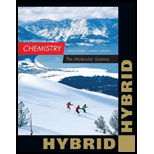
Concept explainers
(a)
Interpretation:
Mean free path of Argon gas has to be calculated.
Concept Introduction:
Mean free path: It is the average distance travelled by a particle between two collisions. It can be calculated using the given formula.
Here,
Ideal gas Equation:
Any gas is described by using four terms namely pressure, volume, temperature and the amount of gas. Thus combining three laws namely Boyle’s, Charles’s Law and Avogadro’s Hypothesis the following equation could be obtained. It is referred as ideal gas equation.
Here,
n is the moles of gas
P is the Pressure
V is the Volume
T is the Temperature
R is the gas constant
(a)
Answer to Problem 119QRT
Mean free path of Argon gas is
Explanation of Solution
Diameter of the atom is determined as follows,
Volume occupied by
Therefore, number of molecules of Argon gas is calculated as given below,
Mean free path of Argon gas is calculated as follows,
(b)
Interpretation:
Mean free path is how many times higher than the diameter of Argon atom has to be calculated.
(b)
Answer to Problem 119QRT
Mean free path is 1390 times higher than the diameter of Argon atom.
Explanation of Solution
Diameter of the atom is determined as follows,
Mean free path of Argon gas is
Mean free path can be compared with the diameter as shown below,
Therefore, mean free path is 1390 times higher than the diameter of Argon atom.
(c)
Interpretation:
Pressure required to change the mean free path of Argon has to be calculated.
Concept Introduction:
Mean free path: It is the average distance travelled by a particle between two collisions. It can be calculated using the given formula.
Here,
Ideal gas Equation:
Any gas is described by using four terms namely pressure, volume, temperature and the amount of gas. Thus combining three laws namely Boyle’s, Charles’s Law and Avogadro’s Hypothesis the following equation could be obtained. It is referred as ideal gas equation.
Here,
n is the moles of gas
P is the Pressure
V is the Volume
T is the Temperature
R is the gas constant
(c)
Answer to Problem 119QRT
Pressure required to change the mean free path of Argon is
Explanation of Solution
Diameter of the atom is determined as follows,
Number of molecules of Argon gas present in
Ratio of moles to liters is calculated to obtain the pressure.
Pressure required to change the mean free path of Argon is calculated using
Want to see more full solutions like this?
Chapter 8 Solutions
Chemistry: The Molecular Science, Hybrid Edition (with OWLv2 24-Months Printed Access Card)
- You have an equimolar mixture of the gases SO2 and O2, along with some He, in a container fitted with a piston. The density of this mixture at STP is 1.924 g/L. Assume ideal behavior and constant temperature and pressure. a. What is the mole fraction of He in the original mixture? b. The SO2 and O2 react to completion to form SO3. What is the density of the gas mixture after the reaction is complete?arrow_forwardGiven that 1.00 mol of neon and 1.00 mol of hydrogen chloride gas are in separate containers at the same temperature and pressure, calculate each of the following ratios. (a) volume Ne/volume HCI (b) density Ne/density HCI (c) average translational energy Ne/average translational energy HCI (d) number of Ne atoms/number of HCl moleculesarrow_forwardIf 4.83 mL of an unknown gas effuses through a hole in a plate in the same time it takes 9.23 mL of argon, Ar, to effuse through the same hole under the same conditions, what is the molecular weight of the unknown gas?arrow_forward
 Chemistry: The Molecular ScienceChemistryISBN:9781285199047Author:John W. Moore, Conrad L. StanitskiPublisher:Cengage Learning
Chemistry: The Molecular ScienceChemistryISBN:9781285199047Author:John W. Moore, Conrad L. StanitskiPublisher:Cengage Learning Principles of Modern ChemistryChemistryISBN:9781305079113Author:David W. Oxtoby, H. Pat Gillis, Laurie J. ButlerPublisher:Cengage Learning
Principles of Modern ChemistryChemistryISBN:9781305079113Author:David W. Oxtoby, H. Pat Gillis, Laurie J. ButlerPublisher:Cengage Learning Chemistry: Principles and ReactionsChemistryISBN:9781305079373Author:William L. Masterton, Cecile N. HurleyPublisher:Cengage Learning
Chemistry: Principles and ReactionsChemistryISBN:9781305079373Author:William L. Masterton, Cecile N. HurleyPublisher:Cengage Learning
 ChemistryChemistryISBN:9781305957404Author:Steven S. Zumdahl, Susan A. Zumdahl, Donald J. DeCostePublisher:Cengage Learning
ChemistryChemistryISBN:9781305957404Author:Steven S. Zumdahl, Susan A. Zumdahl, Donald J. DeCostePublisher:Cengage Learning Chemistry: An Atoms First ApproachChemistryISBN:9781305079243Author:Steven S. Zumdahl, Susan A. ZumdahlPublisher:Cengage Learning
Chemistry: An Atoms First ApproachChemistryISBN:9781305079243Author:Steven S. Zumdahl, Susan A. ZumdahlPublisher:Cengage Learning





